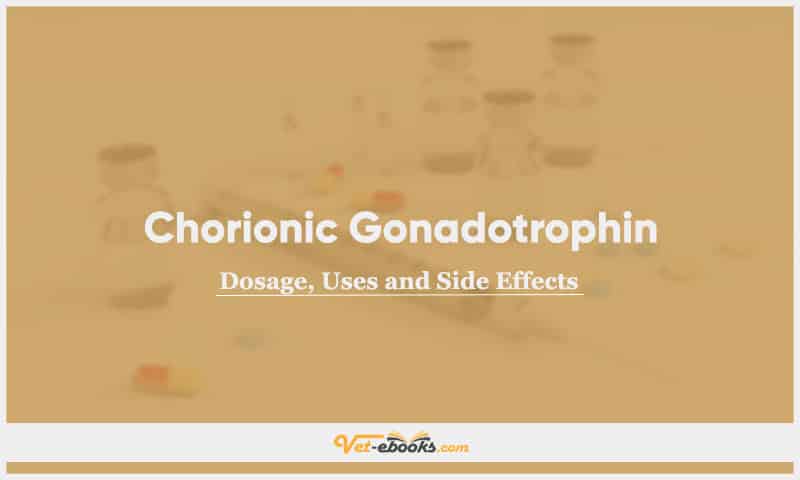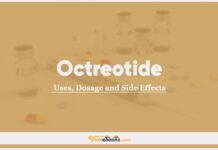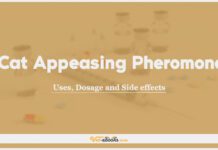Chorionic Gonadotrophin for Dogs, Cats, and Other Animal Species: Dosage, Uses, and Side Effects Guide

Overview
Chorionic gonadotrophin, commonly called human chorionic gonadotropin (hCG), is a hormone that plays an important role in animal reproduction. In veterinary medicine, it’s used to treat a variety of fertility issues in different species — including dogs, cats, horses, cattle, pigs, goats, sheep, birds, and even fish.
This hormone works by mimicking luteinizing hormone (LH), helping to trigger ovulation in females or increase testosterone production in males. Depending on the species, it’s used to induce estrus, manage cystic ovaries, improve sperm quality, or assist with breeding programs. It’s also helpful in certain diagnostic tests to check for reproductive tissues in animals that have been spayed or neutered.
Since hCG is a human-derived hormone, it’s given by injection and handled with care. While most animals tolerate it well, occasional allergic reactions can happen, so it’s important to monitor animals closely during treatment.
Uses of Chorionic Gonadotrophin (hCG)
Chorionic gonadotrophin (hCG) is widely used across multiple animal species to support reproductive health and fertility. Its effects are similar to luteinizing hormone (LH), helping with ovulation, hormone production, and breeding success.
- Dogs and Cats: In dogs, hCG is used to manage delayed ovulation and improve sperm quality in males with low libido. In cats, it can be used off-label to induce ovulation or help diagnose reproductive tissue in spayed animals.
- Horses: In mares, hCG is used to trigger ovulation during estrus, especially when managing breeding schedules. It’s also used in stallions to support testicular development and hormone function.
- Cattle: hCG is approved for treating cystic ovaries in cows and is sometimes used to induce ovulation in synchronized breeding programs.
- Pigs (Swine): In prepubertal gilts and sows with delayed estrus, hCG (as part of PG 600®) helps induce fertile estrus and improve breeding outcomes.
- Goats and Sheep: Used off-label to induce estrus and support breeding management, particularly when combined with other reproductive hormones.
- Birds: Occasionally used to reduce feather plucking behaviors, especially in female birds. Results vary and repeated treatments may be necessary.
- Fish (Finfish): In aquaculture, hCG is approved for use in brood fish to improve spawning and breeding success in both males and females.
Dosage of Chorionic Gonadotrophin (hCG)
The dosage of hCG varies depending on the species and the condition being treated. It is typically given as an intramuscular (IM) or intravenous (IV) injection. Always follow veterinary guidance for proper dosing and monitoring.
Dogs:
- Delayed ovulation: 22 IU/kg IM every 24–48 hours, or a single dose of 44 IU/kg IM. Mate during behavioral estrus.
- Low libido in males: 100–500 IU/dog IM twice weekly for up to 6 weeks to improve semen quality.
Cats:
- Off-label use: Similar dosing to dogs. May be used to induce ovulation or test for residual ovarian tissue in spayed queens. Always consult your vet before use in cats.
Horses:
- Induce ovulation in mares: 1500–3000 IU IV during estrus (when follicle >30–35 mm). Ovulation typically occurs within 48 hours.
- Cryptorchid stallions (under 2 years): 2500 IU IM twice weekly for 4 weeks to encourage testicular descent.
Cattle:
- Ovarian cysts (approved use): 10,000 IU IM (entire vial). May repeat in 14 days if needed.
- Ovulation induction: 1500–2000 IU IM during synchronization protocols (off-label use).
Pigs (Swine):
- Induce fertile estrus (labeled use): 5 mL PG 600® IM in prepubertal gilts or sows post-weaning during delayed estrus.
Goats & Sheep:
- Induce estrus (off-label): 200–800 IU IM or subcutaneously (SC) in the neck region, depending on species and size.
Birds:
- Feather plucking (off-label): 500–1000 IU/kg IM. May repeat after 3 days if no response. Treatment intervals reduce over time with repeated use.
Fish (Finfish):
- Spawning aid (approved use): IM injection near the dorsal fin. Dose depends on species and weight. Refer to product label for exact guidelines.
Drug Dosage Calculator
You Should Give:
Side Effects of Chorionic Gonadotrophin (hCG)
Chorionic gonadotropin (hCG) is generally well-tolerated in animals when used correctly. However, like all veterinary reproductive hormones, it may cause side effects, particularly when used repeatedly or in sensitive animals.
- All Species: Rarely, animals may experience hypersensitivity or anaphylactic reactions. Signs include hives, respiratory distress, or facial swelling immediately after injection. These reactions are uncommon but may require emergency treatment.
- Mares: Some may develop transient hives or mild respiratory distress shortly after hCG injection. In rare cases, repeated doses early in pregnancy (before 35 days) may increase the risk of abortion due to elevated estrogen levels.
- Dogs and Cats: Anaphylactic reactions are possible but rare. No consistent side effects have been widely reported, especially when hCG is used at proper dosages under veterinary supervision.
- Humans (reference data): Injection site pain, gynecomastia (in males), mood changes, and fluid retention have been observed. These side effects are generally not reported in animals but may serve as a reference for potential risks.
Contraindications of Chorionic Gonadotrophin (hCG)
While chorionic gonadotropin (hCG) is a valuable tool in veterinary reproductive medicine, its use must be carefully considered in certain situations. Below are known contraindications and precautions across various species:
- General Precautions (All Species):
- Use cautiously in animals with known hypersensitivity to hCG or its components, especially equine or human-derived proteins.
- Repeat administration may trigger antibody formation, potentially reducing treatment effectiveness over time.
- Always follow appropriate safety protocols, as hCG is classified as a hazardous drug by NIOSH. Wear gloves and avoid skin contact during preparation and administration.
- Dogs and Cats: No specific contraindications reported, but caution is advised in animals with a history of allergic reactions or immune-mediated disorders. Not officially authorized for use in cats; use extra-label only under veterinary supervision.
- Mares: Avoid repeated doses of hCG during the first 35 days of pregnancy, as it may increase the risk of abortion due to elevated estrogen levels.
- Humans (for reference): hCG is contraindicated in patients with androgen-responsive cancers (e.g., prostate cancer), precocious puberty, or prior hypersensitivity to the hormone. While these are human-specific, similar concerns should be considered in veterinary patients.
Some Notes
- Handling and Safety: Chorionic gonadotropin (hCG) is listed by NIOSH as a hazardous drug. Always wear gloves and follow standard safety precautions during preparation and administration, especially when handling the injectable forms of hCG for veterinary use.
- Storage and Stability: Store Chorulon® powder at room temperature (15°C–30°C or 59°F–86°F), protected from light. PG 600® should be kept refrigerated (2°C–8°C or 36°F–46°F). After mixing, most hCG solutions are stable for 30–90 days if refrigerated, but many labels recommend using them immediately. To avoid waste, freezing small aliquots may be a practical option for veterinary clinics.
- Product Types and Availability: Veterinary hCG products such as Chorulon® (10,000 IU) and PG 600® (combining hCG and eCG) are FDA-approved for specific species like cattle, swine, and fish. Extra-label use is common in dogs, cats, and horses for reproductive conditions. Always verify local regulations and consult with a veterinary pharmacist when importing or using these products.
- Species-Specific Efficacy: While hCG is commonly used across species for reproductive support, including inducing ovulation in mares and queens, response rates may vary. In dogs, it may help with delayed ovulation and libido issues, but results can be unpredictable, especially in long-term treatments.
Frequently Asked Questions (FAQs)
What is the primary mechanism of action of chorionic gonadotropin in animals?
Chorionic gonadotropin (hCG) acts as a **luteinizing hormone (LH) analog**, stimulating ovulation in females and testosterone production in males. Its veterinary use is particularly relevant in reproductive cases such as **induction of ovulation** in mares and queens or **improving libido** in male dogs. Understanding this mechanism is essential for applying hCG effectively in **clinical theriogenology**.
How is hCG typically administered in veterinary patients?
Due to its protein nature, hCG must be given **parenterally** (IM or IV), as oral administration renders it ineffective. Peak plasma levels are achieved approximately **6 hours post-IM injection**, which helps guide timing for ovulation induction protocols.
Are there differences between veterinary-labeled and human-labeled hCG products?
Yes. Veterinary-labeled products (e.g., **Chorulon®**, **PG 600®**) are approved for specific species like cattle, swine, and fish. However, **extra-label use** of human-labeled hCG is common in **dogs, cats, and horses** under veterinary supervision. It’s important to be familiar with **regulatory considerations** and proper dosing to avoid complications.
What are the most common clinical uses of hCG in small animal practice?
In small animals, hCG is mainly used to assess the presence of gonadal tissue in **cryptorchid dogs and cats**, manage **delayed ovulation in bitches**, and occasionally to **improve semen quality** in males. Induction of ovulation in queens is another key application.
Can repeated hCG use cause any issues?
Repeated administration may lead to **antibody formation**, potentially reducing the drug’s effectiveness over time. There is also a rare risk of **hypersensitivity reactions**, particularly in mares. Students should note this for **safe drug handling and dosing protocols**.
Do You Want To Increase Your Veterinary Knowledge and Practical Skills?
You Can Now Browse and Download +3000 Books For Veterinary Professionals & Students Online.
Download Veterinary Books















